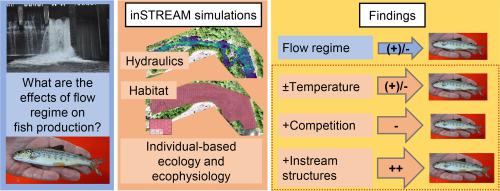Ecological Engineering ( IF 3.9 ) Pub Date : 2021-02-27 , DOI: 10.1016/j.ecoleng.2021.106182 Kristine L. Bjørnås , Steven F. Railsback , Olle Calles , John J. Piccolo

|
Describing and understanding the relationship between streamflow and ecological processes is a classic problem in stream ecology and river management. We applied the individual-based model inSTREAM to describe the relationship between the dynamic river habitat and emergent population responses in sympatric landlocked Atlantic salmon (Salmo salar) and lake-migrating brown trout (Salmo trutta). This application explicitly describes the environmental conditions in the Gullspång Rapids, a residual flow stretch in the hydropower-regulated Gullspång River, Sweden (Svenskt elfiskeregister – SERS, 2019) etween September 2008 and September 2018. We simulated three static minimum flow scenarios and three variable natural flow regimes, contrasting highly artificial conditions with more natural dynamics. Our main response variable was the number of large (≥ 12 cm) out-migrants of salmon and trout, a proxy for successful population recruitment. The baseline model predicted an average production of 455 salmon and 532 trout out-migrants per year during 2008–2018 in this 11,700 m2 spawning and rearing area. The only alternative scenario producing more out-migrants was when the minimum flow was raised by a factor of three, as this led to a modest increase in trout out-migrants. Interestingly, none of the flow alternatives produced more salmon out-migrants than the baseline model, suggesting a competitive disadvantage originating from spawning later than trout. Density-dependent population regulation, a well-known phenomenon in salmonids, was reproduced by the model. Both intra- and interspecific competition was evident. While the number of out-migrants varied with flow regime, sensitivity analyses showed that other model input, specifically velocity shelter availability and stream temperature, were just as important. Increased availability of velocity shelters (in-stream structures that reduces the swimming speed of drift-feeding fish) was the only environmental factor that increased production of both salmon and trout in silico. We conclude that in this system, flow restoration based on simplistic flow scenarios will have limited effect, unless complemented by an increase of instream structural complexity.
中文翻译:

在调节河流中增加最小流量下模拟大西洋鲑(Salmo salar)和褐鳟(S. trutta)的种群反应和相互作用。
描述和理解河流水流与生态过程之间的关系是河流生态学和河流管理中的一个经典问题。我们应用基于个人的模型inSTREAM描述了同养内陆大西洋鲑(Salmo salar)和湖迁移褐鳟(Salmo trutta)的动态河流栖息地与紧急种群响应之间的关系。)。此应用程序明确描述了Gullspång急流中的环境条件,这是水力调节的瑞典Gullspång河中的剩余流量段(Svenskt elfiskeregister – SERS,2019),时间为2008年9月至2018年9月。我们模拟了三种静态最小流量情景和三种变量自然流动状态,将高度人工条件与更多自然动力形成对比。我们的主要响应变量是鲑鱼和鳟鱼大批(≥12厘米)外出移民的数量,这是成功招募人口的代表。基准模型预测,在2008年至2018年期间,在这11,700 m 2中,每年平均生产455只鲑鱼和532只鳟鱼外来移民产卵区和饲养区。产生更多外来移民的唯一替代方案是将最低流量提高三倍,因为这导致鳟鱼外来移民适度增加。有趣的是,没有任何一种替代方法能够比基线模型产生更多的鲑鱼外迁移民,这表明竞争劣势是由比鳟鱼产卵晚产生的。该模型再现了依赖密度的种群调控,这是鲑鱼中的一种众所周知的现象。种内和种间竞争都显而易见。尽管外流移民的人数随流动状况而变化,但敏感性分析表明,其他模型输入,特别是速度掩体的可利用性和溪流温度也同样重要。速度庇护所(增加溪流结构,降低漂流觅食的鱼的游泳速度)的可用性增加,是唯一导致硅石鲑鱼和鳟鱼产量增加的环境因素。我们得出的结论是,在该系统中,除非通过增加河道结构的复杂性来进行补充,否则基于简单流情景的流恢复将具有有限的效果。











































 京公网安备 11010802027423号
京公网安备 11010802027423号